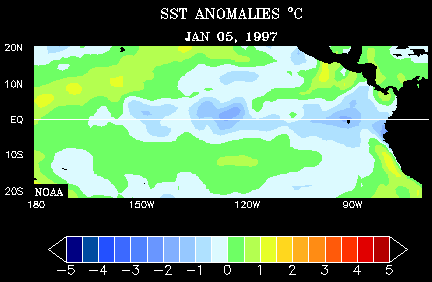The 1997-98 El Niño
The 1997-98 El Niño was one of the most closely followed climate events of the century, as demonstrated by thousands of articles and television stories detailing its prediction, arrival, and eventual impacts. In addition to the extraordinary media scrutiny, the 1997-98 El Niño also represented a major milestone for NOAA. NOAA's trifecta of ENSO detection, prediction, and understanding combined to produce an unprecedented amount of information of such depth and quality that the public was able to prepare for and mitigate El Niño-related climate impacts up to six months in advance.
The warming of Pacific sea surface temperatures was evident by early April 1997. In June, the NOAA Climate Prediction Center issued an ENSO Advisory stating that sea surface temperature anomalies in the central-east Pacific were the largest since August 1983. Until the 1997-98 El Niño, the 1982-83 El Niño was one of the strongest in recorded history and was not detected until the onset of its most devastating impacts.

This animation shows sea surface temperature anomalies during the 1997-98 El Niño. Note the areas along the equator shown in red, where temperatures were warmer than average.
Following the 1982-83 El Niño, improvements were made to the observing system, such as the installation of the TAO/TRITON array of moored buoys that provide NOAA scientists with more comprehensive data concerning the state of the tropical Pacific Ocean. Data collected through the observing system were used in computer models to predict that strong El Niño conditions were going to persist in the Pacific through early 1998. By late June 1997, NOAA scientists issued seasonal climate outlooks for the wintertime months, detailing El Niño-related impacts on U.S. temperature and precipitation patterns.
The high level of accuracy in the winter temperature and precipitation outlooks was unprecedented. When winter finally arrived, NOAA forecasts for heavy rains over the southern tier of the United States and for a mild winter in the Midwest were largely verified.Thanks to outreach efforts made by NOAA, private sector and governmental agencies were able to make use of the predictions to alleviate the most harmful effects. In California, storm damages totaled $1.1 billion, which was half of the $2.2 billion in losses sustained during the 1982-83 El Niño. Thus, the economic and public value of the 1997-98 seasonal outlooks solidified NOAA as a leader in long-range climate prediction.